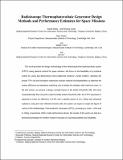Radioisotope Thermophotovoltaic Generator Design Methods and Performance Estimates for Space Missions
Author(s)
Wang, Xiawa; Liang, Renrong; Fisher, Peter H; Chan, Walker R; Xu, Jun
DownloadAccepted version (1.696Mb)
Open Access Policy
Open Access Policy
Creative Commons Attribution-Noncommercial-Share Alike
Terms of use
Metadata
Show full item recordAbstract
This work provides the design methodology of a radioisotope thermophotovoltaic system (RTPV) using spectral control for space missions. The focus is on the feasibility of a practical system by using two-dimensional micropatterned photonic crystal emitters, selecting the proper thermophotovoltaic cell and insulation material to exclude material incompatibilities, to optimize the system efficiency by impedance matching and to design a radiator with minimum mass. In the last section, a design example is presented based on the tested indium gallium arsenide antimonide (InGaAsSb) cells. It is shown computationally that, in using the experimentally tested InGaAsSb cells, the RTPV generator is expected to reach an efficiency of 8.6% and a specific power of 10.1 W∕kg with advanced radiators. Using the more efficient InGaAs cells, the system can expect to triple the figure of merits of the radioisotope thermoelectric generator, promising to reach ∼18% and 21 W∕kg, respectively. With a high performance device, the results of this work can lead to a functional prototype for further research focusing on manufacturability and reliability.
Date issued
2020-07Department
Massachusetts Institute of Technology. Department of Physics; Massachusetts Institute of Technology. Institute for Soldier NanotechnologiesJournal
Journal of Propulsion and Power
Publisher
American Institute of Aeronautics and Astronautics (AIAA)
Citation
Wang, Xiawa et al. "Radioisotope Thermophotovoltaic Generator Design Methods and Performance Estimates for Space Missions." Journal of Propulsion and Power 36, 4 (July 2020): dx.doi.org/10.2514/1.b37623 © 2020 American Institute of Aeronautics and Astronautics
Version: Author's final manuscript
ISSN
1533-3876